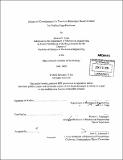| dc.contributor.advisor | Martin L. Culpepper. | en_US |
| dc.contributor.author | Liles, Howard J | en_US |
| dc.contributor.other | Massachusetts Institute of Technology. Dept. of Mechanical Engineering. | en_US |
| dc.date.accessioned | 2010-11-08T17:49:52Z | |
| dc.date.available | 2010-11-08T17:49:52Z | |
| dc.date.copyright | 2010 | en_US |
| dc.date.issued | 2010 | en_US |
| dc.identifier.uri | http://hdl.handle.net/1721.1/59944 | |
| dc.description | Thesis (S.B.)--Massachusetts Institute of Technology, Dept. of Mechanical Engineering, 2010. | en_US |
| dc.description | Cataloged from PDF version of thesis. | en_US |
| dc.description | Includes bibliographical references (p. 47). | en_US |
| dc.description.abstract | An endeavor was conducted to explore the design and development of a two-axis linear reluctance actuator for use as a part of a nano-positioner with the application of serving as a small scale kinematic coupling assembly station. This nano-positioner is designed to be able to accurately and repeatable provide precise motion control of small objects with a resolution on the nanometer scale. This device uses a novel monolithic flexure (Hexflex) that enables it be repeatable to a few nanometers and also very inexpensive to manufacture. The reluctance actuator will provide the force necessary to actuate the positioning system. This actuator type was compared to other actuator types to verify its feasibility and relevance for this application. The actuator operates based off of the reluctance principle used in magnetic circuits and its application as a two-axis actuator is a new and unexplored technology. It will be designed using solid modeling software and magnetic circuit theory, constructed, and tested as a part of the thesis project. Several design iterations were conducted yielding valuable design, manufacturing, and assembly knowledge and insight. Ultimately the actuator did not function properly and consequently did not meet the performance criterion necessary to be incorporated into the nanopositioner system. Due to a correlation disparity between the governing model and the manufactured device, the actuator did not function as predicted and was unusable. Furthermore, after efforts to remedy the problems, the conclusion was reached that the necessary changes would result in the use of this actuator being unfeasible for this application. However, the insight and designs produced from this research has the potential to aid in the further development of this reluctance actuator technology. | en_US |
| dc.description.statementofresponsibility | by Howard J. Liles. | en_US |
| dc.format.extent | 61 p. | en_US |
| dc.language.iso | eng | en_US |
| dc.publisher | Massachusetts Institute of Technology | en_US |
| dc.rights | M.I.T. theses are protected by
copyright. They may be viewed from this source for any purpose, but
reproduction or distribution in any format is prohibited without written
permission. See provided URL for inquiries about permission. | en_US |
| dc.rights.uri | http://dspace.mit.edu/handle/1721.1/7582 | en_US |
| dc.subject | Mechanical Engineering. | en_US |
| dc.title | Design and development of a two-axis reluctance based actuator for hexflex nano-positioner | en_US |
| dc.type | Thesis | en_US |
| dc.description.degree | S.B. | en_US |
| dc.contributor.department | Massachusetts Institute of Technology. Department of Mechanical Engineering | |
| dc.identifier.oclc | 676918698 | en_US |
